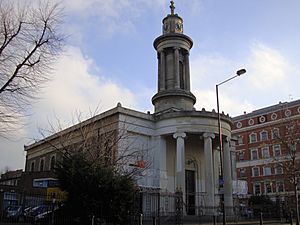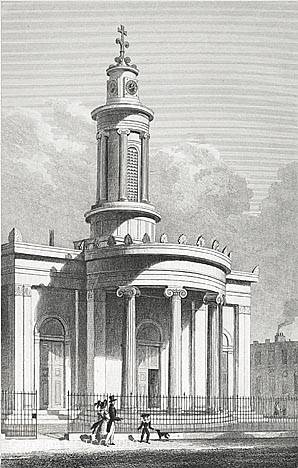All Saints Cathedral, Camden Street facts for kids
Quick facts for kids All Saints, Camden Town |
|
|---|---|
| Greek Orthodox Cathedral Church of All Saints | |

All Saints' Cathedral
|
|
| Location | London, NW1 |
| Country | United Kingdom |
| Denomination | Greek Orthodox |
| Previous denomination | Church of England |
| Website | allsaintsgreekchurch.com |
| Architecture | |
| Architect(s) | William and Henry Inwood |
| Years built | 1822–1824 |
| Administration | |
| Diocese | Thyateira and Great Britain |
All Saints Cathedral, Camden Street, is a beautiful church in Camden Town, London, England. It was first built for the Church of England. Now, it is a Greek Orthodox church. It is officially called the Greek Orthodox Cathedral Church of All Saints. You can find it where Camden Street and Pratt Street meet.
History of the Church
Camden Town started to grow in the 1790s. Back then, it was mostly countryside. It was part of the large parish of St Pancras. The old parish church, St Pancras Old Church, was very old. But it was not close to where most people lived.
In 1822, a new main church was built. This was St Pancras New Church on Euston Road. However, it was mainly for people living nearby. In 1818, a special law was passed. This law helped build new churches in growing areas like Camden Town.
Building All Saints Church
The All Saints church was built between 1822 and 1824. It was first known as the Camden Chapel. Later, people sometimes called it St Stephen's. It officially became "All Saints" in 1920.
The church was designed by a father and son team. They were William and Henry Inwood. They also designed the St Pancras New Church. It is a large building made of yellow bricks. The front and back are covered in Portland stone.
The church has a rectangular shape. It has a round part at the east end. There is also a semi-circular entrance at the west end. Behind this entrance is a round stone tower. This tower has columns around it. It looks like an ancient Greek monument in Athens.
The columns use a special design called the Ionic order. This design came from pieces Henry Inwood brought back from Greece. These pieces are now in the British Museum. Inside, the church has a flat ceiling. There are balconies on three sides. These balconies are held up by Ionic columns.
The building is generally well-liked. However, some people think the tower looks too thin. It is a very important building. It is listed as a Grade I listed building. This means it is a building of special historical interest.
From Anglican to Greek Orthodox
All Saints became its own parish church in 1852. In the 1800s, many people attended church. A survey in 1854 showed that 1,650 people came on Sunday mornings. In the evenings, 1,430 people attended.
In the 1900s, fewer people attended. In 1948, All Saints became a Greek Orthodox church. It kept its original name, All Saints. Another church, St Michael's, became the main Anglican church in Camden Town.
After World War II, many Greek-speaking people moved to the area. Most of them came from Cyprus. The church is still used a lot today. Many worshippers now travel from other parts of London. In 1991, All Saints became a cathedral. This means it is a very important church for the Greek Orthodox community.
The church has been repaired and updated many times. The most recent work started in January 2009. This work was overseen by English Heritage. It was paid for by the National Lottery and donations. These donations came from the Greek Orthodox community.


